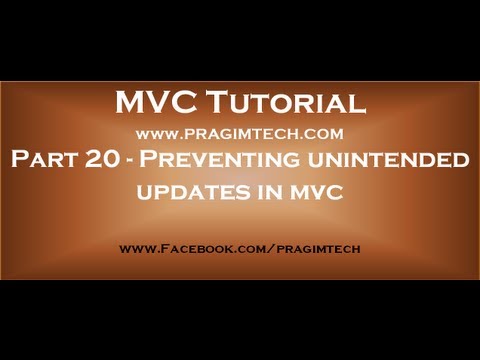Link for code samples used in the demo
Link for csharp, asp.net, ado.net, dotnet basics, mvc and sql server video tutorial playlists
In this video we will discuss, preventing unintended updates in mvc. Please watch Part 19, before proceeding.
Modify “Edit” controller action method that is decorated with [HttpPost] attribute as shown below. This method is present in “EmployeeController.cs” file.
[HttpPost]
[ActionName(“Edit”)]
public ActionResult Edit_Post(int id)
{
EmployeeBusinessLayer employeeBusinessLayer = new EmployeeBusinessLayer();
Employee employee = employeeBusinessLayer.Employees.Single(x =] x.ID == id);
UpdateModel(employee, new string[] { “ID”, “Gender”, “City”, “DateOfBirth” });
if (ModelState.IsValid)
{
employeeBusinessLayer.SaveEmployee(employee);
return RedirectToAction(“Index”);
}
return View(employee);
}
Please note:
1. The name of the method is changed from “Edit” to “Edit_Post”
2. The method is decorated with [ActionName(“Edit”)] and [HttpPost] attributes. This indicates that, this method is going to respond to “Edit” action, when the form is posted to the server.
3. The “id” of the employee that is being edited, is passed as a parameter to this method.
4. Using the “id” parameter we load the employee details(Id, Name, Gender, City & DateOfBirth) from the database.
Employee employee = employeeBusinessLayer.Employees.Single(x =] x.ID == id);
5. We then call UpdateModel() function. This should automatically update “Employee” object with data from the posted form. We are also passing a string array as the second parameter. This parameter specifies the list of model properties to update. This is also called as include list or white list. Notice that, we did not include “Name” property in the list. This means, even if the posted form data contains value for “Name” property, it will not be used to update the “Name” property of the “Employee” object.
UpdateModel(employee, new string[] { “ID”, “Gender”, “City”, “DateOfBirth” });
So, if we were to generate a post request using fiddler as we did in the previous session, “Name” property of the “Employee” object will not be updated.
Alternatively, to exclude properties from binding, we can specify the exclude list as shown below.
[HttpPost]
[ActionName(“Edit”)]
public ActionResult Edit_Post(int id)
{
EmployeeBusinessLayer employeeBusinessLayer = new EmployeeBusinessLayer();
Employee employee = employeeBusinessLayer.Employees.Single(x =] x.ID == id);
UpdateModel(employee, null, null, new string[] { “Name” });
if (ModelState.IsValid)
{
employeeBusinessLayer.SaveEmployee(employee);
return RedirectToAction(“Index”);
}
return View(employee);
}
Notice that we are using a different overloaded version of UpdateModel() function. We are passing “NULL” for “prefix” and “includeProperties” parameters.
UpdateModel[TModel](TModel model, string prefix, string[] includeProperties, string[] excludeProperties)

